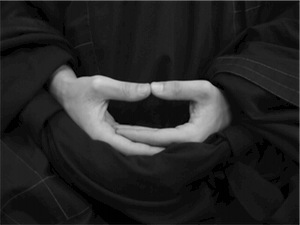The posture of zazen
 Sit on the zafu (cushion) cross legged. In lotus position, put your right foot on the left thigh and bring the left foot up onto the right thigh. In half-lotus, put your right foot on the left thigh and alternate. The weight of the body is placed on three points: the knees pushing against the ground and the perennial muscle which presses against the zafu. The spine is straight and vertical. The back is flexed, and the shoulders are relaxed. The chin is tucked in, the back of the neck is stretched. Push the top of your head up towards the sky. The mouth is closed and the tongue touches the upper palate and the inside of the two front teeth. This calms “interior chatting”. The eyes are semi- closed and look down towards the ground, about one meter in front, without looking at anything in particular.
Sit on the zafu (cushion) cross legged. In lotus position, put your right foot on the left thigh and bring the left foot up onto the right thigh. In half-lotus, put your right foot on the left thigh and alternate. The weight of the body is placed on three points: the knees pushing against the ground and the perennial muscle which presses against the zafu. The spine is straight and vertical. The back is flexed, and the shoulders are relaxed. The chin is tucked in, the back of the neck is stretched. Push the top of your head up towards the sky. The mouth is closed and the tongue touches the upper palate and the inside of the two front teeth. This calms “interior chatting”. The eyes are semi- closed and look down towards the ground, about one meter in front, without looking at anything in particular.
Breathing
Breathe calmly through the nose, remaining totally conscious of it, meaning being attentive to each breath, like a tiger on the watch. Breathe naturally and breathe out calm, long, deep breaths all the way under the navel. Don’t judge your breathing – if its slow or rapid –, it is just the way it is.
Little by little with the practice, breathing out becomes soft, slow, peaceful, long and deep, pushing the abdominal mass downwards and creating a concentration of energy in the zone which is called the ki kai tanden (ocean of energy) located under the navel. At the end of the breath, breathing in is done naturally. Masters have compared Zen breathing to the mooing of a cow or the breathing of a baby who cries once he’s born.
This natural abdominal breathing helps us to have a more correct view of reality, because it is no longer perceived through the prism of our imagination. We clearly perceive that breathing is the link between the body and the mind and at the same it is only wind.
The state of mind
Letting thoughts, images, memories , which appear during zazen, go by, like clouds in the sky, without trying to hold on to them, to develop them, or to chase them away. The practice of Zen is supported by nothing : no visualization, no concentrating on an object, nothing, nothing at all… just nothing and for nothing or so then for the whole universe, for the living.
Letting zazen do zazen
Our force of life must neither be too loose nor too taut. What is important is that it remains entirely in a state of awakening. Zen meditation is an effort without effort : accepting not to do anything physically or mentally special, so that the mind meets the mind. In our lives, depending on the circumstances, we are always ready to do a lot of things; stripping oneself of all the “doing”; means coming back to the normal condition of the mind.






